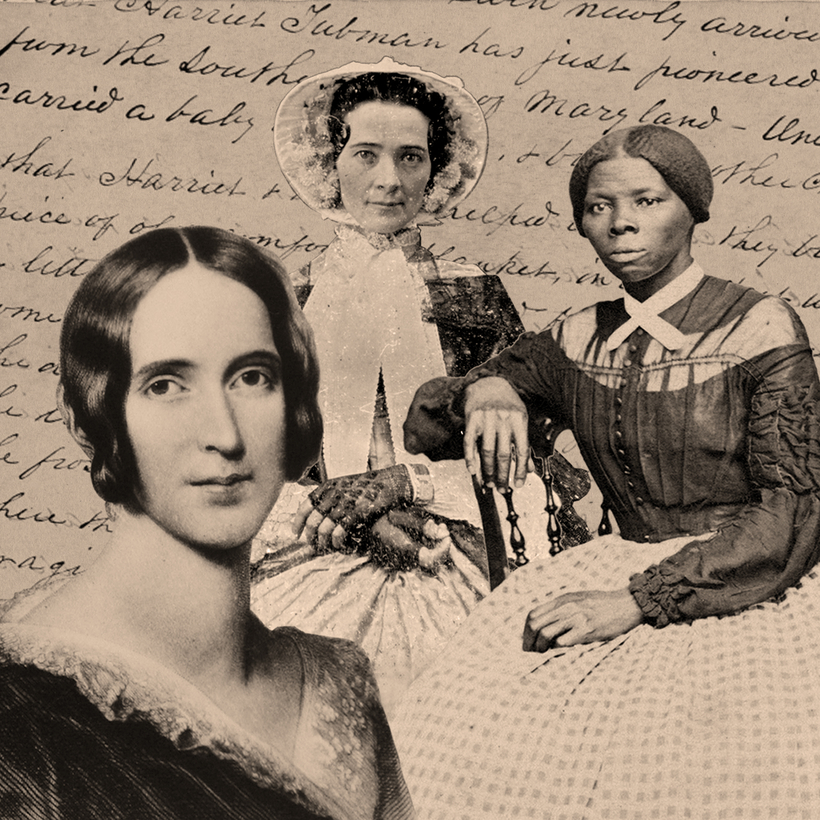Did you ever hear the story about Harriet Tubman’s final Underground Railroad operation?
One night, in December 1860, she arrived with six passengers at the home of her friend Martha Coffin Wright, a Quaker abolitionist who lived in the industrial town of Auburn, in upstate New York. Harriet had been followed closely by slave catchers from the Eastern Shore, and it took her a month to safely lead the group into the free North.
Later, Martha wrote to her daughter Ellen about Harriet’s account of her journey: “They walked all night, carrying the little ones, and spread the old comfort on the frozen ground, in some dense thicket, where they all hid, while Harriet went out foraging & sometimes could not get back till dark, fearing she would be followed. Then if they had crept further in, & she couldn’t find them, she would whistle or sing certain hymns, & they would answer.”
Harriet Tubman left behind no written history of her life, but she was a wry, graphic raconteur with a keen sense of how her stories affected her listeners. Friends and audiences took down what she said, and passed along their awed impressions of her feats. Pieced together, these scenes form an incomparable oral history of an American hero.
Agent of Progress
After the onset of the Civil War, Harriet convinced Northern officials to send her to Union-occupied Port Royal, South Carolina. The army had barely begun admitting Black men, much less Black women, but she created her own position, as a scout and spy—a job she described to Martha as a “kind of secret service.”
In the summer of 1863, she helped an abolitionist colonel and his Black troops execute a raid along the Combahee River, designed to destroy several rice plantations and liberate the enslaved population. Harriet described landing at the Nicholls Plantation at dawn, and watching hundreds of people rushing to the dock: “Here you’d see a woman with a pail on her head, rice a smoking in it just as she’d taken it from the fire, young one hanging on behind, one hand ’round her forehead to hold on, the other digging into the rice-pot, eating with all its might; ’hold of her dress two or three more; down her back a bag with a pig in it.”
Harriet was also a shrewd propagandist. After their triumphant return, the gunboats filled with 750 freed people, she dictated a letter to a supporter who ran an abolitionist newspaper in Boston. She essentially wrote his piece for him, adding: “Don’t you think we colored people are entitled to some credit for that exploit, under the lead of the brave Colonel Montgomery?”
The army had barely begun admitting Black men, much less Black women, but Harriet Tubman created her own position, as a scout and spy.
Letters and oral histories provide rare access to people’s inner lives, and sometimes to the epic events they helped to shape. Harriet had met Martha through Martha’s older sister, the human-rights crusader Lucretia Mott. In turn, Martha introduced Harriet to her close Auburn ally, Frances Seward, the aristocratic wife of the anti-slavery statesman William H. Seward.
Frances, too, opened her basement kitchen to freedom seekers, and Auburn became one of Harriet’s regular stops on the Underground Railroad. When William moved to Washington, serving first as a senator and then as secretary of state to Abraham Lincoln, Frances defiantly stayed in Auburn.
With the election of Lincoln, seven states seceded, and in Seward’s final speech as senator, attempting to keep the country from shattering, he assured still-loyal southerners that the new president would not abolish or interfere with slavery in any state. Frances, in an astonished rage, dashed off a letter accusing him of abandoning convictions he’d held his entire life: “Compromises based on the idea that the preservation of the Union is more important than the Liberty of nearly 4,000,000 human beings cannot be right.”
Martha Coffin Wright, Harriet Tubman, and Frances Seward are the “agitators” of my book. Through their accounts of their everyday lives, I discovered how they transformed themselves from ordinary women with no power to change anything into insurgents who helped to foment the second American revolution.
As Union soldiers were slaughtered in one battle after another, and officials in Washington argued about whether to pursue emancipation, Harriet never doubted the purpose or outcome of the war. She believed, as did Martha and Frances, that the conflict was a “holy war,” fought to carry out God’s will and to fulfill the promise of the Declaration of Independence. In 1865, as the carnage continued, Harriet talked about the staggering notion of white men fighting for Black freedom. She said that after all the years in which the blood of her race had been spilled in vain, white sons were being taken from their parents “to bring the call for justice home to their hearts.”
Dorothy Wickenden is the executive editor of The New Yorker and author of Nothing Daunted: The Unexpected Education of Two Society Girls in the West. The Agitators: Three Friends Who Fought for Abolition and Women’s Rights is out now from Scribner

